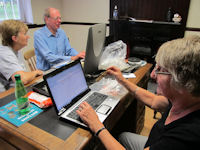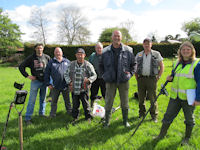
Figure 6: Sketch map depicting concentrations of musket balls on the battlefield
Although marked as a battle of national significance within the Historic Scotland Inventory of Battlefields, the Battle of Philiphaugh, fought on the outskirts of Selkirk, Scottish Borders, in 1645, also represents an important case study to illustrate the potential level of impact that may result from decades of unchecked metal detecting activity. However, every dark cloud has, as they say, a silver lining, as the project offered an opportunity to implement working strategies with the aim of mitigating further impact on an already seriously damaged site. Before discussing these strategies it is necessary to provide some background to the site and the project.
Previous desk-based assessments of the battlefield had identified little in the way of metal detecting activity on the site, except for the odd forays by the estate gamekeeper. This, together with low impact from development owing to its rural location, identified Philiphaugh as a relatively well-preserved battlefield with a high archaeological potential in the form of artefact scatters (Foard 2005, 7). The actual condition of the battlefield, however, only came to light during a recent community archaeology project directed by the author in 2011. The reality proved to be very different: it became clear through the course of the project that the battlefield had been intensively metal detected by a number of individuals from the local area over a 30-year period. A programme of systematic metal detecting survey recovered very little in the way of battle-related artefacts, with only one scatter of pistol balls identified. This was in contrast to the large volume of material reported to the author over the course of the project by local metal detectorists, including an assemblage of 50 musket balls and 25 pistol balls recovered by one individual. To accompany the assemblage, and at the request of the author, he also produced a rough sketch map based on where he remembers finding lead projectiles in significant concentrations (Fig. 6). This map at least helped to identify what could have been the core area of the battlefield (Ferguson 2011, 17). With this evidence in mind, the author came to the unfortunate conclusion that intensive and prolonged activity of hobbyist metal detectorists had significantly affected the archaeological integrity of the battlefield landscape. The erosion of existing artefact scatters as a result of the unrecorded removal of battle-related scatters had occurred to such an extent that it is possible only a fraction of the battlefield has survived. In total seven metal detectorists from the local area came forward with information relating to activity on the battlefield, but few had retained the material they had recovered or could report exactly where it had been found; all were invited to take part in the project.
Throughout the project metal detectorists who had volunteered to take part were encouraged to participate in all aspects of fieldwork, including excavation of a ditch that may have been used as a defensive feature during the battle. Skills such as artefact identification and analysis, map reading and use of a hand-held GPS unit were all introduced and supported by a series of workshops and hand-outs (Plate 8). As the project progressed, so too did their knowledge and awareness of the battlefield as a significant archaeological site. Some even became frustrated about their past activity on the battlefield, with one volunteer metal detectorist commenting during the survey that if he had known how important the site was he wouldn't have come near the place. It is important to acknowledge that those who had previously metal detected on the site and ultimately adversely affected its survival did not do so as a malicious act of vandalism or looting, but as a result of a lack of understanding of how the battlefield existed in the archaeological record. As the site is recognised as nationally significant within the Historic Scotland Inventory of Battlefields (Historic Scotland 2012), the author strongly recommended that any further hobbyist metal detecting on the site would be inappropriate outside an archaeological survey and therefore should be restricted by the landowner. Recruiting local metal detectorists was an important step in this process, as their engagement with the project invoked a strong sense of stewardship towards the battlefield, which is necessary to ensure future protection of the site—members of the original team remain watchful for any unsolicited activity on the site. Those who have decided to continue metal detecting the fringes of the battlefield have agreed to record their finds and report them to the author, who now works in the Treasure Trove Unit (Plate 9).


Plate 8: Metal detectorists volunteering to catalogue artefacts recovered during survey
Plate 9: Members of the metal detecting team at Philiphaugh
Internet Archaeology is an open access journal based in the Department of Archaeology, University of York. Except where otherwise noted, content from this work may be used under the terms of the Creative Commons Attribution 3.0 (CC BY) Unported licence, which permits unrestricted use, distribution, and reproduction in any medium, provided that attribution to the author(s), the title of the work, the Internet Archaeology journal and the relevant URL/DOI are given.
Terms and Conditions | Legal Statements | Privacy Policy | Cookies Policy | Citing Internet Archaeology
Internet Archaeology content is preserved for the long term with the Archaeology Data Service. Help sustain and support open access publication by donating to our Open Access Archaeology Fund.
File last updated: Thu Feb 28 2013